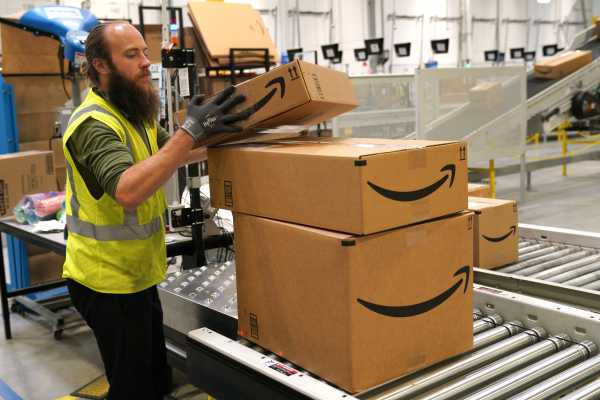

Last year, shoppers spent $7.9 billion on Thanksgiving Day and Black Friday. An additional $6.59 billion was dropped on Cyber Monday. This year, Black Friday sales alone are expected to jump to $9.1 billion. And one retailer dominates these sales: Amazon.
Last year, Amazon accounted for 45 percent of all Thanksgiving Day online purchases and 60 percent of purchases on Black Friday, according to Hitwise. The Seattle e-commerce giant is expecting similar numbers this year, and has been making an even more aggressive push, offering free shipping to all shoppers during the holiday season, with no minimum purchase.
While this may be great for Amazon’s bottom line, all this shopping has a real human cost. As plenty of Amazon employees have attested, working in the company’s warehouses is grueling. Earlier this summer, a former Amazon fulfillment center manager from California reached out to me after I wrote about Sen. Bernie Sanders (I-VT) sparring with Amazon over worker rights and pay rates. (The battle ended in Amazon raising the hourly rate to $15 an hour but cutting company stock grants and bonuses.) The former Amazon employee, a US Air Force veteran, requested anonymity for fear of professional repercussions.
I talked with the former Amazon employee a few times over the past several months to learn what it’s like to work inside an Amazon warehouse. We recently discussed the Black Friday shift. They spoke about long and punishing hours, how morale plummets as the holiday season goes on, and why the holidays still make them feel guilty.
(After this article published, an Amazon spokesperson emailed Vox with the following statement: “This is an unfortunate experience. But for many of the managers and associates in fulfillment centers, the holiday season is a fun, exciting place to work. All managers go through trainings that are intended to set their departments up for success and similar trainings are offered to hourly employees. All employees are encouraged to bring their questions, comments, or concerns directly to their managers as direct communication is an essential part of Amazon’s peculiar culture.”)
My conversation with the former Amazon employee is below, edited for length and clarity.
How did you land a job at an Amazon warehouse?
I’ve always wanted to live in Seattle, and it’s hard to move there without working for Amazon because they are the largest employer. I heard they pay corporate employees really well, and I have friends who work there. Some hate it; others have been there 10 years.
I applied to a job after I finished serving in the Air Force Reserves in 2014, but then decided to go to graduate school for business administration. After I finished school, I figured I’d take a warehouse job and transfer internally, which never happened. I was at a fulfillment center in California from September 2016 to August 2017.
What was your job title and salary?
I was an area manager, inside a new facility that had about 1,000 associates. I oversaw the packers, managing about 55 associates. My salary was $80,000, which is on the higher end. They gave me more because I said I wouldn’t accept anything less, since I had a master’s.
Were there a lot of US vets working at your facility?
Yes, it’s a pretty typical thing for Amazon. It’s easy for Amazon to hire us because they know vets are willing to shut up and cooperate. In my opinion, Amazon is preying on the work-life balance issue that the military has, and feeds off the rigid order the Army teaches. The military is known for being a bastion of sexism, but I had a worse experience at Amazon. It’s way more cutthroat.
What was the assembly line like inside your facility?
Basically, a Kiva robot will pick a pod that looks like a four-sided shelf and has the items people ordered. The robot will bring this pod to the picker, and its screen tells them what item to grab. The picker will grab that item, scan it, throw it into a tote, and that tote will go out to people packing packages. Associates at my facility put out about 60 packages an hour [per person].
What’s it like working inside these fulfillment centers?
During my first few weeks of training, when I was just observing, it was clear to me immediately how hard this job is. The associates have mandated breaks where they have to clock in and out by certain times, but the managers do not get any sort of break or lunch. Most of us just never ate. Everyone is on their feet for 12 hours a day.
Are all those reports about timed breaks and surveillance true?
Yes, it is all extremely accurate. We had to track how long someone hadn’t packed or picked something. If we saw that five minutes went by without any activity from an associate, we were supposed to go over and talk to that person. Everything is tracked inside Amazon because all the packages are being scanned and have time stamps. I would watch the internal system on my laptop and monitor all the packers to make sure there were no dead spots in packing rates that might be due to a system problem.
We didn’t specifically have timed bathroom breaks, but the break system was rigid. Associates got a 30-minute lunch break, two 15-minute breaks, and an additional 15 minutes of “time off tasks.” If they did nothing for a set period of time, the system would note they were off task. If they had an emergency they needed to leave the area for, I could scan their badge or go back and change their time off task later to an actual task, but bathroom breaks weren’t something we were supposed to change time off task for.
If someone was out for more than 30 minutes, it was a first writeup, unless they’d been written up for time off task before, then it would be a progressive writeup. If they were off task for more than an hour, it was an immediate firing.
It was really difficult for me because the firings were automatic in the system in general, and I had no control over helping out associates. I had to fire people multiple times, and they were devastated because they counted on the health insurance.
Can you walk me through your time at the warehouse on Black Friday and Cyber Monday?
The managers all showed up at 5 am. Typically, we’d arrive at 6:30 am, but we went early for an internal pep talk and to make sure all stations were perfect and ready for associates, that there were boxes at all stations, and that the floor was clear for the Kiva robots to run correctly. The associates showed up at 7 am.
Once they got to their stations, the chaos began. You’re just trying to make things stay as stable as possible. The volume of orders on Black Friday is like what happens when Amazon opens the floodgates; we were at full capacity, and we just never stopped. I remember looking at the backlog and watching the orders go from 10,000 to 300,000, and just thinking that we’d never be out of it. The backlog was even higher on Cyber Monday, because Cyber Monday is actually busier for Amazon than Black Friday.
Amazon is a very well-oiled machine, so it doesn’t look like chaos. But it’s all so frantic, you feel like you’re in chaos. It’s extremely busy, but it’s still organized.
What was the messaging Amazon corporate tried to give to warehouse workers?
They wanted us managers to give a lot of pep talks to the associates. They would tell us to say, “We’re doing something really special, we’re bringing Christmas people across the country! This is something you should be proud of!” It was pretty tone-deaf. They were trying to pump people up, but they ignored the long-term problems they had at the fulfillment centers, which is that their associates barely survived the shifts.
People who worked Black Friday got time and a half, so everyone was initially very happy, but by the time the Christmas season was over, people were so burnt out that we lost a significant amount of staff. Everyone was beyond exhausted.
What were the hours like?
On Black Friday and during the holiday season, everyone works six days a week. The associates work 10 hours a day, the managers 14 to 18. It’s mandatory overtime, the hours are not voluntary, and they are all on your feet. Amazon is also really strict about taking time off during Black Friday. You weren’t allowed to use your PTO for Black Friday, and if you missed it, you were at risk of getting fired.
What was the age range of associates you worked with?
It was 50-50 between young people and [middle-aged] people. Half were straight out of high school, and they didn’t take it very seriously. The other half were older and just trying to make a living for their families.
What was the morale inside the fulfillment center during Black Friday and the holiday season?
At the start of it all, it was fine. Everyone was happy. People even said, “Yes, I’m bringing Christmas to my family. I’m working these crazy long hours, but I’m getting time and a half.” But after five weeks, people were frustrated, tired, and they didn’t want to be there anymore.
Another part of my job that was really frustrating was that after the holiday season was when Amazon determined promotions and raises, which is really messed up because everyone is on a post-Christmas crash. You are coming back to work after your most stressful time on the job, and it’s so brutal because there’s all these built-up frustrations. And yet that’s when we had to talk about promotions and raises. I found it to be extremely manipulative and unfair.
Was it tough to be a boss in this type of position?
Yes, it was really hard. The way I handled it all is one of my biggest regrets till this day. Like, machines break, things happen, and I wish I would have been more reassuring to the associates I was managing. There was this little old lady who reminded me so much of my mother, and one time I had to give her a write-up because she wasn’t making her packing rate, and she was very, very close to getting fired. I wish that I had been more sympathetic to her. I really disliked being in that position.
Do you think Amazon could have trained you better as a manager?
Amazon never trained us in how to communicate with associates. We weren’t trained to be understanding of their struggles or communicate with them. It was all about mechanics. And Amazon has built the system so that managers and workers have entirely different incentives. Workers constantly feel like their jobs are on the line, because they are. We were supposed to be observing their [packing] rate and not be concerned with how hard it is to pack things. Managers were pressured to identify the weak links and get them out so that we can have a faster rate. It’s a pressure cooker environment, and that’s what you have to be to get to Amazon’s level of efficiency.
Would Amazon be a better place to work if they took a more humane approach to their warehouses?
It could help, but I also think that would be a Band-Aid for the real problem, which is that the workers need to unionize. It’s immoral at this point, considering we all basically got anti-union training. Some associates at Amazon do make good money, but that does not replace workers’ comp or fair work conditions.
What are your thoughts on people who say workers on Black Friday benefit because they get time and half?
I’d say that while Amazon associates did get overtime, they are still severely underpaid while being on their feet for 12 hours. There’s a lot of human cost here, a lot of time lost with family.
What do you think about Amazon’s pay increase to $15 an hour?
Honestly, they should be pushing for more. I think they should be paying for $20 an hour. Jeff Bezos is obscenely rich, and in any moral society, he would not have that much money.
Do you shop during Black Friday or Cyber Monday today?
I do. I boycott Prime Day, but I do shop on Amazon during Black Friday. I feel bad about it, but at the same time, I don’t think me not shopping will get Amazon to change its practices. And I shop on Amazon because my family lives far away from me, and it’s the easiest way to send presents to them. But I think about what I saw in the fulfillment centers a lot, and I have a lot of regret. I think this time of year is probably ruined for me.
What do you want people to know about Amazon and Black Friday?
People need to know that their free shipping comes at a human cost. They might be shopping for things that are cheaper and arrive faster, but those packages are artificially cheap. They are being paid for in other ways. People who are watching the expansion of Amazon need to know that it’s not necessarily a good thing. Sure, you’ll get cheaper and faster packages. But Amazon runs on a logistics system that’s based off working people to the bare bones.
Update 11/20: Updated to include a statement from Amazon.
Clarification 11/21: This post has been updated to clarify that the Amazon fulfillment center the former warehouse manager worked at put out 60 packages per hour, per associate.
Sourse: vox.com






